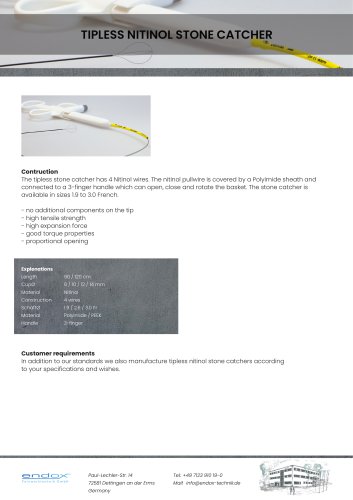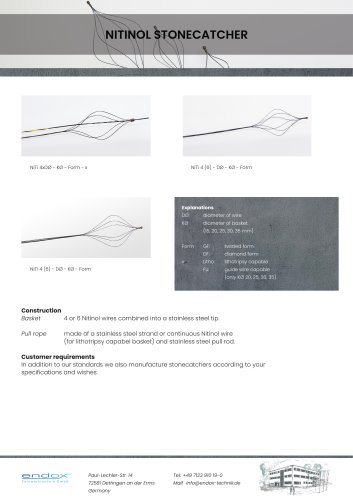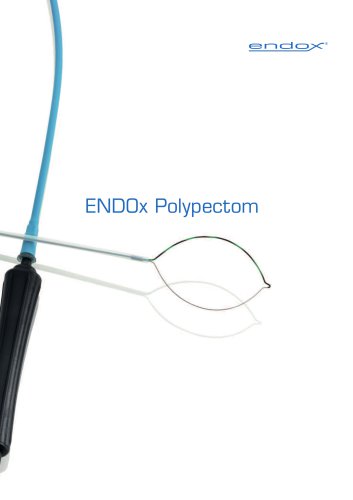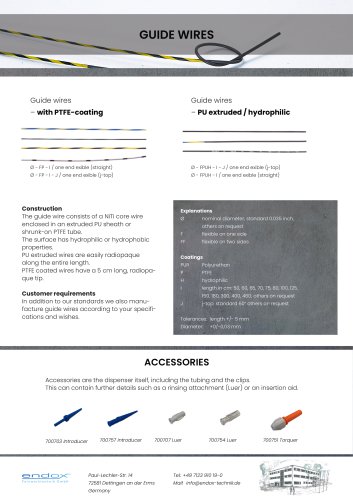
Catalog excerpts

Endoscopic SubmucosaResection (ESR) l with Flat Adenoma Resection Instrument s (FARIn ) endox Feinwerktechnik GmbH, Paul-Lechler-Str.14, 72581 Dettingen/Erms, Phone +49 (0)7123 91019-0 info@endox-technik.de, www.endox-technik.de © 2013 by Endox / Farin
Open the catalog to page 1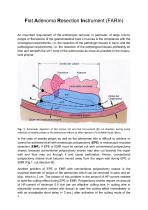
Flat Adenoma Resection Instrument (FARIn) An important requirement of the endoscopic removal, in particular, of large (>2cm) polyps or flat lesions of the gastrointestinal tract´s mucosa is the compliance with the oncological requirements, i.e. the resection of the pathologic tissues in sano, and the pathological requirements, i.e. the resection of the pathological tissues preferably en bloc and beneath the sm1 zone of the submucosa as close as possible to the muscularis propria. Fig. 1: Schematic depiction of the correct (A) and the non-correct (B) cut direction during snare resection of...
Open the catalog to page 2
HF-generator. In flexible endoscopy normally available HF-surgical generators can generate a maximum amount of HF-current of 1.5 to 2.0 Aeff. In the case of sessile polyps or flat adenomas with a diameter of 2 cm (without or including a safety distance of minimum ca. 3 mm from the border of the pathologic tissue) coresponding to a circumference of 6 cm or more, an amount of HF-current of ca. 3 Aeff is required for an immediate start of the cutting effect. Fig. 2: General depiction of the amount of HF-current (red), HF-voltage (blue), electric power (black) and electric energy (green) during...
Open the catalog to page 3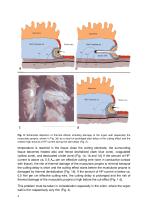
Fig. 3: Schematic depiction of thermal effects including damage of the organ wall (especially the muscularis propria, shown in Fig. 3d) as a result of prolonged start delay of the cutting effect and the relative high amount of HF-current during the start delay (Fig. 2). temperature is reached in the tissue close the cutting electrode, the surrounding tissue becomes heated also and hence devitalized (dark blue zone), coagulated (yellow zone), and desiccated (violet zone) [Fig. 1a, 1b and 1d]. If the amount of HFcurrent is above ca. 0.5 Aeff per cm effective cutting wire (wire in conductive...
Open the catalog to page 4
Fig. 4: Proportional depiction of the thickness of different parts of the human colon in comparison to different polyps. . To avoid prolonged cutting delay, some HF-surgical generators are provided with a special start modus for the cutting effect, which generates a short but high HF-current pulse (>> 2 Aeff) after each activation of a cut-mode. If the amount of the HF-current pulse is too aggressive, the tissue can be cut to fast with the result that quick transected blood vessels cannot become HF-surgically closed synchronously during the quick transection. To avoid the above discussed...
Open the catalog to page 5
General description of the FARIn The Flat Adenoma Resection Instruments (FARIn) consist of a catheter (1), an effector (2) on its distal end, and an actuator (handle) (3) on its proximal end. Fig. 5: Flat Adenoma Resection Instrument. 1 = catheter, 2 = effector, 3 = actuator, 4 = connector of the HF-Current Cable. The catheter of the FARIn is made of PTFE, is 2 m in length and has an external diameter of 2.3 mm. The catheter is transparent for visual control of axial movements of the yellow / blue market arc of the effector (2) and hence control of opening or closing of the effector. The...
Open the catalog to page 6
Fig. 6: The asymmetric effector consists of an electrically insulated spring-elastic NITINOL wire (2), an only 1.5 cm short flexible cutting-wire (3), an electrically insulated stop-wire (4), and an electrically insulated spur (5). The arc (2) of the effector is made of dimensionally- and shape-stable spring-elastic NITINOL™ wire, which is coated with electrical insulation (yellow-blue). The arc is significantly more rigid and les flexible than the cutting wire (3) and tightens the flexible cutting wire like the bow used for archery tightens its bow string. The proximal end of the arc is...
Open the catalog to page 7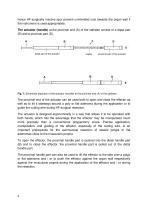
hence HF-surgically inactive spur prevent unintended cuts towards the organ wall if the instrument is used appropriately. The actuator (handle) at the proximal end (A) of the catheter consist of a distal part (B) and a proximal part (D). Fig. 7: Schematic depiction of the actuator (handle) at the proximal end (A) of the catheter. The proximal end of the actuator can be used both to open and close the effector as well as to tilt it sideways around a poly or flat adenoma during the application or to guide the cutting wire during HF-surgical resection. The actuator is designed ergonomically in...
Open the catalog to page 8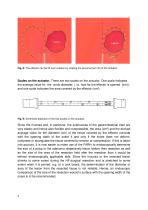
Fig. 8: The effector can be tilt over a lesion by rotating the proximal part (D) of the actuator. Scales on the actuator. There are two scales on the actuator. One scale indicates the average value for the circle diameter, ( i.e. how far the effector is opened (cm)), and one scale indicates the area covered by the effector (cm²). Fig. 9: Schematic depiction of the two scales on the actuator. Since the mucosa and, in particular, the submucosa of the gastrointestinal tract are very elastic and hence also flexible and compressible, the area (cm²) and the derived average value for the diameter...
Open the catalog to page 9
The symmetric resection snare consists of electrical insulated spring elastic wire parts (2, 3) on its proximal end, as well as an electrical insulated spur respectively skid (5) on its distal end, and a relatively short (1,5 cm) electrical non-insulated RF cutting wire (4) between the electrical insulated parts (2, 3) of the snare and the electrical insulated skid (5). Because the electrical insulated parts (2, 3 and 5) do not cut, this resection snare cannot cut in vertical direction respectively into the muscularis propria, and hence it can be pressed against the organ wall respectively...
Open the catalog to page 10
The automatically adjusting incision needle The automatically adjusting incision needle consists of an electrically insulated skid (2) with a HF-surgical incision respectively cutting needle-electrode (3) and is freely rotatable at the distal end of a 2.3 mm catheter (1). Because the skid is bended outside the distal end of the catheter, the needle electrode (3) becomes adjusted automatically vertical against the surface of a tissue when the skid is moderate pressed against the surface of the tissue. Hence, this incision instrument can be used without an assistant at the proximal end of the...
Open the catalog to page 11All Endox Feinwerktechnik catalogs and technical brochures
-
STAINLESS STEEL STONECATCHER
1 Pages
-
SNARES
1 Pages
-
NITINOL STONECATCHER
1 Pages
-
ENDOx Polypectom
3 Pages
-
WIRE / STRAND SECTIONS
1 Pages
-
DISPENSER
1 Pages
-
HYPOTUBE
1 Pages
-
Guide Wire Standard
1 Pages



